Just when everyone got their hopes up for a fresh new decade, the year 2020 brought us a global pandemic that rocked our day-to-day lives. All of our routines got the axe entirely or were shifted to adapt to a newly contagious world, including how we learn, how we congregate, and how we shop.
And if the risk of catching the novel virus wasn’t enough to encourage hunkering down, stay-at-home orders swept nearly every state in the U.S. at some point in 2020. These factors made heading out to run your usual errands unsafe and unlawful.
This perfect(ly terrible) storm created the ideal climate for one industry to thrive: ecommerce.
More people than ever click-clacked away on the interwebs to order everything from groceries to toilet paper to fun things to take their mind off the dire events or stuff into care packages. And Route got a front-row seat to the whole shebang.
With our metaphorical stethoscope tuned into the pulse of ecommerce, we got to see the trends of Black Friday and Cyber Monday unfold first-hand. See what li’l nuggets we uncovered about the most unprecedented holiday shopping season in our lifetime.
Ecommerce Grew in 2020, Yada Yada…
As alluded to earlier, ecommerce thrived in 2020 (unlike our New Year’s resolution to “get out and meet new people” 🤡). Just as quickly as brick-and-mortar stores had to amplify their digital efforts, consumers had to find brands and retailers they could turn to for reliable online shopping.
Before the coronavirus pandemic hit the U.S., it was forecasted that 2020 would see around 227 million online shoppers. Instead, millions of people were suddenly put in the position where their only choice was to start shopping online—so that’s exactly what they did. The pandemic pushed the total number of online shoppers in 2020 past the original estimate to hit 256 million online shoppers in the U.S.
That’s nearly 30 million more than expected, or 13% growth in the sheer quantity of consumers. But what about the quality of the consumer? Otherwise put, how much did shoppers spend?
According to a report by Adobe, total U.S. online spending in May 2020 hit $82.5 billion, an increase of 77% year-over-year. Throughout the year, ecommerce grew 44% and represented 21.3% of total retail sales. In 2019, there were only two days outside the holiday season when shoppers spent more than $2 billion online. For comparison, online shoppers spent more than $2 billion online every single day from May through June—with a few $3 billion days tossed in there for fun. It’s the fastest pace U.S. ecommerce has chugged along in more than 20 years (which is basically since it became A Thing).
If ecommerce had simply kept tootin’ along at the pace it was in the forecasts from 2019 or earlier, it would’ve taken 4 to 6 years for the industry to hit those lofty numbers. And remember, that number was pulled from May, a historically unexciting and unremarkable month for shopping.
Another sign of the times is the controversial ecommerce thermometer itself, Amazon. In the fourth quarter of 2016, the company generated an impressive $43.7 billion in revenue. Fast-forward to Q4 2020. It was Amazon’s largest revenue-earning quarter in the books, touting $125.56 billion in sales, and accounted for one-third of all online retail.
What’s more is that despite the unfathomable pandemic-induced ecommerce growth throughout 2020, a dramatic decline isn’t forecasted for 2021 as vaccines roll out and the pandemic loses power. Growth of at least 6% is anticipated for the year ahead, with positive momentum continuing for as long as we can see.
Shifts in How We Buy and What We Buy
Not only did consumers make seemingly overnight shifts in where they shopped, they also altered what they shopped for. Here’s a quick overview of categories that succeeded or suffered in this online shopping spree:
Ecommerce Categories That Grew
- Disposable Gloves +670%
- Weight Training +307%
- Snacks +185%
- Hand Soap & Sanitizer +262%
- Baking Ingredients +84%
- (Related) Bread Machines +652%
- Hair Coloring +115%
Ecommerce Categories That Struggled
- Luggage –77%
- Clocks –39%
- Bridal Clothing –63%
- Wine Racks –40%
- Classroom Furniture –35%
- Wheels & Tires –46%
- Event & Party Supplies –55%
Many of these shifts have obvious reasons. With gyms closed, more people turned to piecing together makeshift gyms for daily sweat sessions. Similarly, more weddings were postponed, and odds are good that a lot of wine went straight from paper bag to first pour, cutting out that wine rack middleman altogether.
With loads of people having heaps of newfound time stuck in their homes, consumers spent less money on goods to go places or see lots of people. Instead, shoppers focused their spend on more intimate hobbies (like dying their hair, which may have happened right after they cut their own bangs).
Plus, with the rise in working from home, learning from home, and connecting with friends and family through online meetings, computer sales hit double-digit growth at a 13% increase—the biggest leap since 2014.
More Packages, More Problems
While many online merchants were able to stay nimble and navigate the rocky road of going digital-only basically overnight, the ecommerce surge exposed a lot of cracks in the industry’s foundation. With more packages than ever flooding mailrooms and box trucks, 2020 saw its fair share of logistical SNAFUs.
1. Shipping Delays
Affectionately dubbed “Shipaggedon,” postal workers and carriers were stressing the importance of ordering holiday gifts early in order to avoid a truly insurmountable number of packages from November onward. With unforeseen ecommerce growth, carriers were already hitting their capacities before Halloween.
In order to help ease the blow, many retailers elongated their holiday discounts and deals so that the onslaught from condensed shopping on Black Friday and Cyber Monday didn’t totally ruin shipping logistics (and the holidays). And with the pandemic still surging as the holidays drew closer, 75% of consumers planned to stay safe and do their holiday shopping online—a 65% increase from 2019.
And unlike a flood of egg nog, a flood of packages had carriers like UPS and FedEx worried about facing a shortfall of 7 million packages every day throughout the season. Thankfully, with massive hiring and extending hours through weekends, delays were kept as minimal as possible, all things considered.
2. Increased Package Theft
Package theft was at an all-time high at the start of 2020, and, well, it only got worse from there. Around 1.7 million packages are stolen or lost every day in the U.S., and one in three folks reported falling victim to package theft. Despite the increased use of video surveillance, smart doorbells, signature requirements, and secure lockers like the ones provided by Amazon, porch pirates still seem mostly undeterred.
Maybe they can’t see big white Nest cameras through their burglar masks, or maybe the pandemic has numbed them to any sort of care, but porch piracy during a pandemic is especially troubling considering many packages were essentials or even medication.
By the end of 2020, 43% of online shoppers experienced package theft—with most respondents reporting having packages stolen on more than one occasion. (As if 2020 couldn’t have been any worse!)
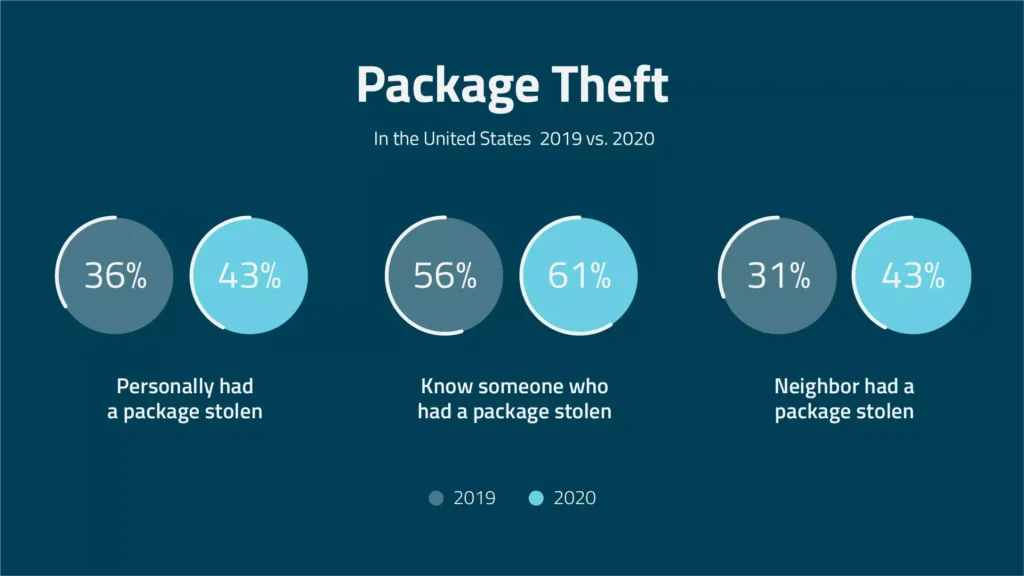
3. Unsatisfied Customers
All of those stolen packages and delayed (or lost) packages culminated with a bunch of unhappy customers. Even if many of these things like unbridled thievery and unprecedented online ordering were completely out of the hands of online brands and package carriers, customers didn’t really care.
Many felt like retailers or carriers—anyone—should be trying harder to deliver a better customer experience (and, ya know, their packages). Providing a better experience that meets expectations means working closer with customers to keep them in-the-know regarding their purchase’s status as well as resolving issues when they show up.
Subrah Iyer, CEO and cofounder of Moxtra, says it best:
“Consumers’ expectations have gone digital, and there’s no turning back. Regardless of a shift back towards pre-pandemic life, the convenience and flexibility of a digital customer experience is here to stay. Businesses need to adopt digital solutions to keep customers satisfied and continue growing their businesses.”
Nearly half of merchants are going to focus on creating a better customer experience over the next five years, especially since 86% of customers will pay more to get that great experience. Not only does a better experience foster trust and loyalty, but it’s also a fool-proof way for brands to differentiate themselves in a saturated industry.
Since the very first items were bought and sold online, most resources and attention have been paid to customer acquisition. This past year, however, made it glaringly obvious that the post-purchase customer experience is, perhaps, more crucial to overall satisfaction than any other part of the customer journey.
Route’s Homegrown Black Friday and Cyber Monday Insights
Route is the premier customer experience platform that provides ecommerce merchants with the tools they need to provide an engaging journey and foster brand loyalty beyond checkout. We had a front row seat to consumer trends regarding package tracking and claim filing throughout the 2020 holiday shopping season. Check out what we learned.
Modern consumers want to track their purchases.
When we say “tracking,” we mean real-time tracking with engaging and proactive notifications—not the experience of finding a buried tracking email, clicking a link, an entering a clumsy 20-digit number on a carrier’s website.
Even pre-pandemic, 93% of consumers stated they wanted proactive shipping and delivery updates, with 81% saying those critical updates are key to whether they make that coveted second purchase or go to a competitor. The need for package tracking that meets and exceeds customer expectations has never been more evident.
When looking at how many consumers were tuned into tracking options and using the Route app to watch their purchases, there’s a stark difference between 2019 and 2020 holiday seasons.
At a Glance: Users Tracking Packages in Route
2019 Holiday Season
Pre-BFCM: 4,626
Black Friday: 10,210 (+120.7%)
Cyber Monday: 6,265 (+35.43%)
Return to Pre-BFCM levels: Dec. 4
2020 Holiday Season
Pre-BFCM: 158,555
Black Friday 2020: 258,101(+62.8%)
Cyber Monday 2020: 249,414 (+57.3%)
Return to Pre-BFCM levels: Dec. 6
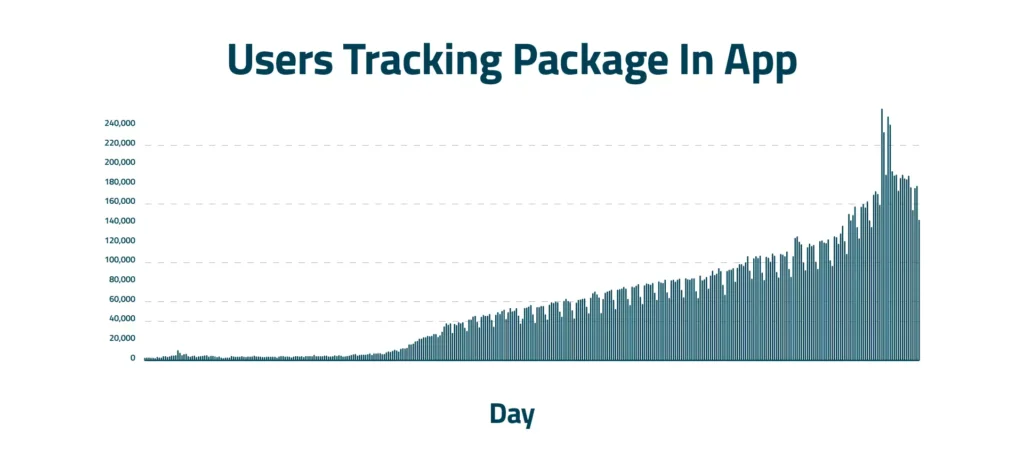
While there were larger single-day spikes in 2019, more consumers were tracking packages over a longer span of time in 2020.
What This Means
It’s possible that the longer duration of tracking traffic was due to delays in shipping, another likely reason could be that consumers were spreading out their holiday shopping over more days instead of condensing them into just Black Friday or Cyber Monday.
Different carriers delivered different claim rates.
There are a lot of stereotypes about how different carriers treat packages, but Route has the numbers to prove some of those accusations. Customers file claims when their goods go missing, are delayed, or get stolen. This year, we learned which carriers handled the influx of packages better than others by comparing the number of claims customers filed for each one.
At a Glance: Carrier Claim Rates & Types
FedEx
- November ‘19: 0.00096
- November ‘20: 0.0016
- Change: +67%
United States Postal Service
- November ‘19: 0.0009
- November ‘20: 0.0025
- Change: +177%
UPS
- November ‘19: 0.0014
- November ‘20: 0.0021
- Change: +50%
DHL Global Mail
- November ‘19: 0.00056
- November ‘20: 0.0024
- Change: +329%
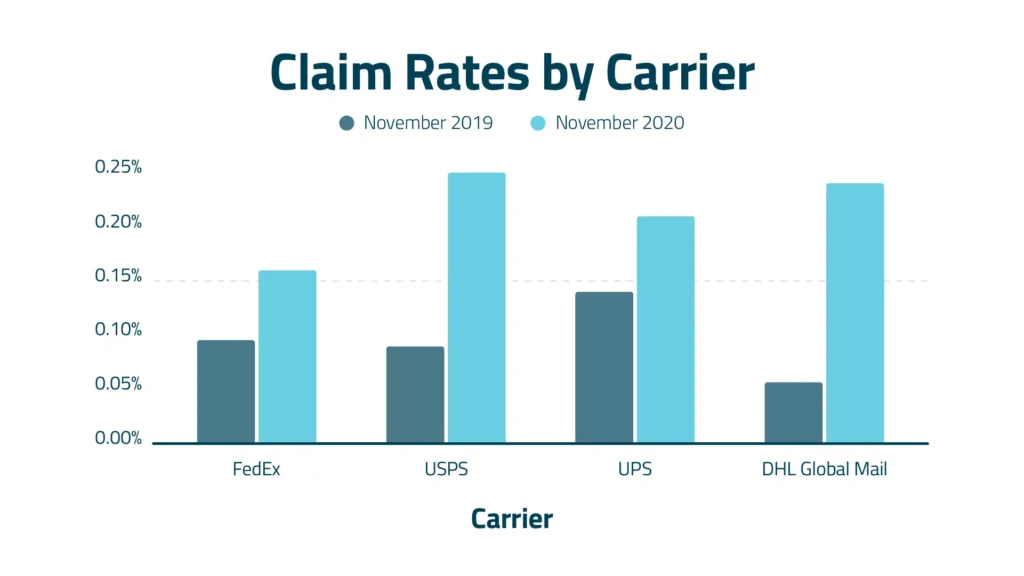
Claim Breakdown:
- Lost package: 71%
- Damaged product: 11%
- Stolen package: 18%
What This Means
While it’s hard to pin package theft on carriers, the truth is that all claims—no matter how out of your control they are—reflect on the brand and the customer experience. After experiencing a poor last-mile delivery experience, a massive 84% of consumers aren’t likely to shop with the brand again. It’s important to pick a caring and reputable carrier as part of delivering a better experience, but ultimately, it’s up to merchants to try and squelch any claim before they get started.
Claims were up in most metros.
Just like how big cities have more fire hydrants, they also have more traffic, more crime, and—in 2020—more risk in regards to catching an airborne virus.
At a Glance: Claim Rates by Location
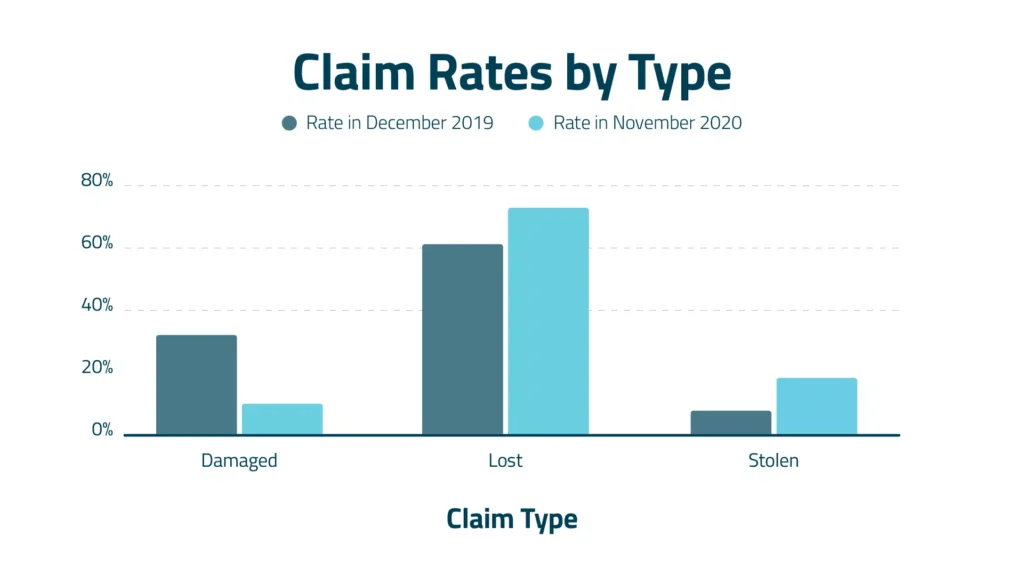
- The top 10 cities have had significant claim rate change (most up 20%+) while overall claim rate has actually decreased.
- LA up 46%, Houston up 100%, NYC up 122%, Philadelphia up 120.5%, San Diego up 331%
- Las Vegas is the outlier: Down 29% since last November
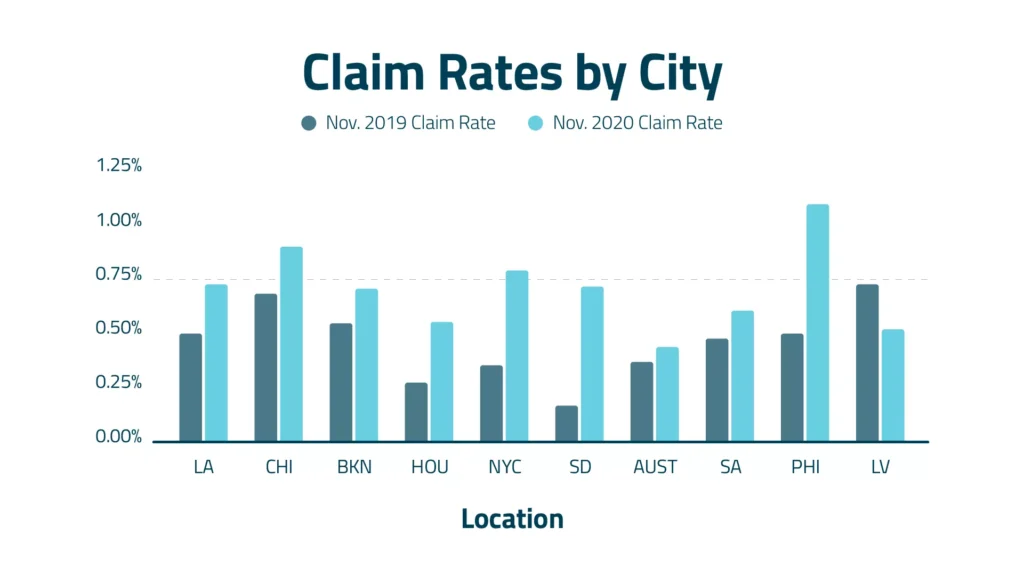
What This Means
If most of your customers hail from big cities, offering package protection could be huge for your brand and building customer loyalty. With more packages entering metros with already strained shipping logistics, more losses, delays, and thefts are bound to happen in dense regions.
Las Vegas is the anomaly, but there are a few guesses for why the city saw fewer claims than in 2019. One reason could be that Las Vegas relies tremendously on tourism. In 2019, the city saw more than 42 million visitors come through, which is massive for a city with a permanent population of just around 630,000. In 2020, Vegas had fewer than 20 million visitors. With fewer people, fewer cars, fewer sticky hands, fewer tourists receiving orders—all of it adds up to fewer claims.
A second reason could be that major recipients of packages—casinos, hotels, restaurants—weren’t ordering as much as frequently, or they were shut down entirely. Fewer packages could also be the reason behind fewer claims. We suspect once the pandemic ebbs for good and Las Vegas returns to business as usual, claims will spike.
Prepare for a Wild 2021 Ecommerce Holiday Season (Like, Now)
One of the biggest lessons that the 2020 holiday shopping season taught the world of ecommerce is to be prepared. While no one predicted a global pandemic spanning more than a year, nearly everyone could have predicted the increasing need for digital-first strategies and better customer experiences.
It’s impossible to put an end to the problems that leached into ecommerce throughout the most chaotic year of the century (at least we hope it was), but there are ways to combat delays, loss, and theft while preserving your bottom line.
Encourage Customers to Track with Route
Consumer behavior changed throughout 2020, and the popularity of ecommerce that’s come to light isn’t expected to go anywhere once coronavirus is eradicated. With more packages being shipped than ever, there are more opportunities for delays, loss, and theft. This leaves customers worrying about their purchases and bogging down customer support lines. Did you know?Pre-parcel anxiety is a thing that your customers experience. A better customer experience starts with removing that worry from their minds.

It’s no longer sufficient for merchants to send an email with a tracking link buried inside to customers. With 83% of U.S. shoppers expecting regular communication about their purchase, it’s clear that modern consumers want proactive and transparent updates about the journey their package is on from warehouse to delivery.
Connecting their store to Route enables merchants to show customers where their purchases are in real time on a real map. Customers get push notifications sent directly to their phone, which they can click to learn all the details they crave, such as ETA, location, and more—no inbox hunting required.
With customers having an easier path to tracking their packages, merchants experience 246% more branded impressions than email updates alone, and they experience a 45% decrease in customers asking “Where is my order?” More brand engagement, fewer resources, and happier customers are possible with modern tracking.Explore Route Track
Offer Package Protection at Checkout
With the influx of ways a package can get off track and never make it home, there are a lot of frustrated customers out there. The only thing that’ll make the situation worse is if there’s no way to resolve the problem and frustration continues to grow. If a delivery is botched and the customer has to eat the cost, no matter the cause, 94% of customers will blame the retailer.
One way to offer peace of mind no matter what happens is to give shoppers the choice to add package protection to their purchase. For pocket change, a shopper can protect their purchase from damage, loss, and theft. Their minds will be at ease knowing that even if a porch pirate hits their stoop before they do, their package is protected because the merchant had their back.
Brands that offer protection provide a better experience that customers will return for when it comes to shop again. Merchants using Route see an 11.5% increase in net profits, 95% CSAT from shoppers, and an 18% decrease in costs to their customer support teams. Explore Route Protect
Reduce Friction to File Claims
Offering to fix problems won’t mean anything to your customers if filing a claim proves to be an impossibly frustrating task. We’ve all been in customer support purgatory before. Being tossed from a support chat robot to an email chain to on-hold for hours on the phone is a game of hot potato that’ll have customers churning and leaving bad reviews in their wake.
Nearly half of shoppers say they aren’t likely to return to a merchant if they have a poor returns experience, which means making it tough to file a claim could be enough to break any bit of loyalty.
Ecommerce sellers know all too well the costs associated with acquiring new customers, but reducing friction wherever possible, creating a better customer experience, and increasing customer retention just 5% can improve profits by 75%.
Route enables merchants to offer easy, fast, and automatic claims filing. Customers just head to the app, choose what the issue is, and submit.
Route can approve claims automatically and offer a refund or resend the purchase in less time that it takes to even access support at most stores. This saves merchants from doing loads of tedious tasks all while solidifying customer trust and turning bad experience into a great one.
Engage Throughout the Entire Journey
Earlier we mentioned how the history of ecommerce has revolved around customer acquisition. Indiscriminate email blasts, ubiquitous discounting, blazing fast shipping, websites that shock and awe—all tools of the trade to pique interest and get shoppers through the digital doors.
As shopping behaviors continue to evolve, it’s becoming clearer that the modern consumer isn’t as wild about pricing and shipping as they once were. Instead, their decisions are more likely to be made based on which brand offers the better experience throughout the entire shopping journey.
Bad experience: Getting a customer’s money and sending them vague, intermittent, and frustrating communications about where the heck their stuff is.
Good experience: Nurturing a customer to purchase, offering to protect their purchase until they have it in their arms, and engaging with real-time, transparent updates the entire way.
In other words, nobody likes being ghosted.
Merchants should take advantage of every opportunity they have to engage with customers, especially post-purchase. Sellers that use Route can create their own branded profiles, deploy branded notifications, and even show personalized promo content to customers in the app. It’s a chance to earn 246% more customer engagement, 126% more branded impressions, and boost clicks back to their store by 26% to win repeat purchases.
As much sense as prolonged engagement makes for ecommerce merchants, it also leaves customers feeling satisfied, loyal, and better about the brands treating them with care and consideration past checkout. Explore Route Engage
Find the Silver Lining of 2020 Ecommerce
The global pandemic took its toll on every part of life in 2020, whether for the worse or the better. The rush to online shopping pushed the entire ecommerce world into hyperspeed, with stores and D2C brands evolving faster than anyone expected.
As the world returns to pre-pandemic living, one thing that definitely won’t ebb with masking, hand sanitizer, and social distancing is the prevalence of ecommerce in everyday routines. Most experts predict that the consumer behaviors and expectations picked up the past year are here to stay. This means that 2021 is not the time to abandon any lessons, insights, or processes picked up along the hair-raising ride that was 2020.
Your customers are going to continue to expect transparency, tracking, honesty, and updates about the stuff they purchase. Brands that stop offering the opportunities to watch shipping milestones or purchase package protection will be the ones that see the biggest decline in revenue and loyalty in the year ahead. However, the brands that keep exceeding those expectations and delivering better customer experiences—especially during the nail-biting post-purchase phase—will be the ones that stand out and thrive for the long haul.